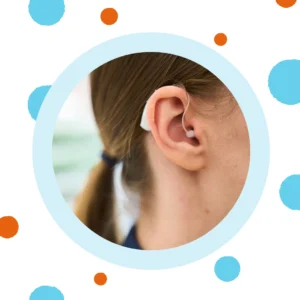
Hearing Aid App: Your Key to Hearing Aid Success
Your hearing aids came with an app. You downloaded it. Now what? Modern hearing aid apps do more than adjust volume. They let you fine-tune
Home » Effective Strategies to Alleviate TMJ Ear Pain: Symptoms & Relief Options

Experiencing ear pain with no sign of infection? TMJ may be the culprit. This condition affects the hinge connection between your jawbone and skull, often leading to ear discomfort. We’ll guide you through recognizing TMJ ear pain and offer actionable relief strategies, without confusing medical jargon or unnecessary details.
Table of Contents
Toggle
TMJ disorder is a complex condition that stems from the temporomandibular joint, the hinge that connects your jawbone to your skull. Its proximity to the ear canal, coupled with shared nerve pathways, makes it a common cause of ear pain. If you’ve ever experienced a persistent dull irritation or a sharp, intense pain radiating in and around your ear, you might be suffering from TMJ-related ear pain.
The discomfort from TMJ disorders doesn’t stop there. These disorders can also trigger a variety of sensations in the ear, like sharp or thumping pain below or in front of the ear, tinnitus, or even a feeling of blocked eustachian tubes. So, if you’ve been plagued by ear pain and your doctor has ruled out ear infections, it might be worth considering a consultation with a TMJ specialist.
Now, here’s the tricky part. TMJ disorders and ear infections can present with overlapping symptoms, making it difficult to differentiate between the two. This confusion can lead to misdiagnosis and, consequently, ineffective treatment.
But fear not, the following subsections will help you distinguish between the common symptoms of TMJ ear pain, the signs of an ear infection, and when to consult an ENT specialist.
When it comes to TMJ disorders, one of the most common symptoms is jaw pain. This can manifest as a persistent dull or sharp sensation, often exacerbated by actions such as talking, chewing, or yawning. Alongside jaw pain, difficulties with jaw function, like locking of the jaw joint or challenges in mouth opening, are notable symptoms of TMJ disorders. In some cases, individuals may even experience searing pain in their jaw.
The pain from TMJ disorders can extend to various areas, creating a wide spectrum of discomfort, including:
Ear pain from TMJ can vary from a dull throb to a sharp ache, often worsening with jaw movement. Another common auditory indicator of TMJ disorders is a popping or clicking sound when opening or closing the mouth, hinting at issues within the jaw joint.
Ear infections, on the other hand, have their unique set of symptoms. Classic signs include sharp pain within the ear, fever, and hearing loss. In children, ear infections may lead to additional symptoms such as trouble sleeping and loss of balance.
While adults with ear infections may not experience all the same symptoms as children, they are not exempt from the discomfort. The primary symptoms for adults are ear pain and the drainage of fluid, which can be quite unsettling. If you or your child are experiencing these symptoms, it’s advisable to seek medical attention promptly to rule out an ear infection.
Now, you might be wondering when it’s time to seek professional help. An ENT (ear, nose, and throat) specialist is well-equipped to evaluate your ear, including auditory functions and the condition of the eardrum, helping differentiate between earaches caused by TMJ disorders and other underlying conditions.
If you are experiencing ear pain that lasts for more than a day, is severe, or is accompanied by discharge from the ear, it’s time to schedule a consultation with an ENT specialist. They can help pinpoint the cause of your discomfort and guide you towards the appropriate treatment.
If a “crackling sound in ear when moving jaw” has caught your attention, you’re not alone. This auditory quirk is often a sign of TMJ disorder or Eustachian tube dysfunction. Within this article, our experts at Injoy Hearing will uncover why these sounds occur, how to diagnose them, and what steps you can take to silence the crackle.
Now that we’ve explored the symptoms and how to differentiate TMJ-related ear pain from an ear infection, let’s delve into the various remedies that can help manage TMJ pain. From over-the-counter medications to moist heat application, relaxation techniques, and specific exercises, there’s an array of treatment options available to help alleviate the discomfort associated with TMJ disorders
Let’s break these down in the following subsections:
When it comes to TMJ pain, simple home care strategies can go a long way. Establishing a daily relaxation routine can mitigate TMJ symptoms that are worsened by stress, jaw clenching, and teeth grinding. This could involve deep breathing exercises, progressive muscle relaxation, or even a calming yoga session.
Another crucial aspect is diet. Consuming a diet rich in anti-inflammatory foods, like fruits, vegetables, whole grains, and fish, can contribute significantly to the management of TMJ disorders. On the flip side, it’s advisable to avoid inflammatory foods, including sugar, refined carbohydrates, and fried foods, which can exacerbate the condition.
Physical therapy exercises for TMJ pain are designed to improve jaw movement and strengthen jaw and surrounding muscles, thereby reducing discomfort. These exercises might involve gently stretching the jaw, massaging the TMJ area, or resting the front teeth on a pencil. They’re straightforward and can be easily incorporated into your daily routine.
The closing jaw exercise, for example, focuses on strengthening jaw muscles, while the opening jaw exercise provides resistance during mouth opening to exercise the jaw. When performing these exercises, it’s important to feel resistance without pain. As this resistance improves over time, it’s an indicator that your muscles are strengthening, bringing you one step closer to relief.
In addition to home care strategies and physical therapy exercises, mouth guards can play a crucial role in managing TMJ pain. Custom-fitted mouth guards can:
Tinnitus, often described as a persistent ringing, buzzing, or humming sound in the ears, is a condition that affects millions worldwide. While tinnitus is not technically a disease, it can significantly impact one’s quality of life. It can cause discomfort, anxiety, and even interfere with everyday activities. The origins of tinnitus vary, from exposure to loud noises and age-related hearing loss to underlying medical conditions. This elusive sensation can affect anyone, regardless of age or hearing health. Finding hearing aids for tinnitus can help.
While home care strategies, physical therapy exercises, and mouth guards can provide relief, there are instances where medical interventions might be necessary, especially for chronic TMJ ear pain.
The following sections will take a closer look at these interventions, including prescription medications, advanced dental treatments for upper and lower teeth, and surgical options.
Prescription medications can play a critical role in managing severe TMJ-related ear pain. Nonsteroidal anti-inflammatory drugs (NSAIDs) such as naproxen, piroxicam, and meloxicam can alleviate inflammation and pain associated with TMJ disorders. In parallel, muscle relaxants like cyclobenzaprine and metaxalone may be prescribed to alleviate discomfort, often used in short-term alongside other pain medications.
In addition to NSAIDs and muscle relaxants, tricyclic antidepressants can be used to treat TMJ pain, control bruxism, and aid with sleeplessness. For extended relief, corticosteroid injections or botulinum toxin type A injections may also be considered.
Sometimes, TMJ disorders can be traced back to dental issues. Inappropriate dental occlusion can contribute to TMJ pain, and undue pressure from teeth grinding and poor bite alignment can lead to jaw muscle discomfort and extend pain to the ear. In such cases, orthodontic treatment may be recommended to address the misalignment issues contributing to TMJ disorders.
Orthodontic appliances, like braces or other corrective devices, are effective in aligning teeth to correct bite issues and alleviate associated TMJ pain. So, if your TMJ pain persists despite other treatments, it might be worth having a conversation with your dentist about the potential benefits of orthodontic treatment.
For some people, less invasive treatments might not provide sufficient relief. In such cases, surgical interventions for TMJ disorders can be considered. These can range from minimally invasive procedures like arthrocentesis and TMJ arthroscopy, which can be utilized when symptoms persist despite conventional treatment attempts, to more complex procedures like modified condylotomy or open-joint surgery.
It’s important to note that surgical options are generally considered only when other treatments have failed to manage serious jaw joint issues. Therefore, it’s crucial to exhaust all other treatment options and discuss potential risks and benefits with your healthcare provider before considering surgery.
Tinnitus produces a variety of internal sounds, like ringing or buzzing, that only the individual can hear. Whether constant or intermittent, severe cases can hinder concentration and mask external sounds, affecting quality of life.
While home remedies, physical exercises, and medical interventions can provide relief from TMJ pain, it’s important to recognize when to seek help from a TMJ specialist. TMJ disorders are complex and vary between individuals, making personalized treatment plans essential.
Let’s delve into the importance of a detailed dental history and diagnostic procedures in diagnosing TMJ disorders.
A thorough dental history is crucial for diagnosing TMJ disorders. It helps TMJ dentists ascertain possible causes and tailor treatment plans accordingly. The location and onset of pain, along with any aggravating and relieving factors, are vital pieces of information that can guide the diagnosis and treatment of TMJ disorders.
Your dental history should include information on past treatments and other pain disorders, as these can provide valuable insights into your condition. Hence, when visiting a TMJ specialist, be prepared to provide a detailed dental history to assist in devising a comprehensive treatment plan for your TMJ disorder.
In addition to a detailed dental history, certain diagnostic procedures help in diagnosing TMJ disorders. These include checking for signs such as tooth wear, bruxism, abnormal mandibular movements, and tenderness of the muscles of mastication. A comprehensive evaluation also involves detailed medical and dental history to evaluate signs of overuse.
Advanced imaging techniques, such as dental X-rays, CT scans, and MRIs, can provide detailed images of teeth, jaw, and soft tissue related to the TMJ. In some cases, TMJ arthroscopy, a diagnostic method that uses a camera to inspect the joint space, may be used for a less invasive evaluation. These procedures aid in categorizing TMJ disorders into myofascial pain, derangement of the joint, and degenerative joint diseases such as arthritis.

Now that we’ve covered the symptoms, diagnosis, and treatment of TMJ disorders, let’s focus on lifestyle adjustments that can prevent TMJ flare-ups. Here are some tips:
These adjustments can significantly improve TMJ symptoms and contribute to long-term relief.
Let’s delve deeper into these strategies in the following subsections.
Stress is a common trigger for TMJ disorders. It can lead to involuntary jaw clenching and teeth grinding, contributing to strain on the TMJ. Adopting effective stress management techniques can help mitigate jaw tension and alleviate TMJ symptoms.
Techniques such as biofeedback, transcendental meditation, progressive muscle relaxation, diaphragmatic breathing, and guided imagery are scientifically supported methods to manage stress and reduce its impact on TMJ. Additionally, counseling can play a key role in teaching TMJ disorder patients to recognize and change behaviors that worsen jaw pain, such as stress-related clenching.
Diet also plays a significant role in managing TMJ pain. Here are some soft foods that can help minimize jaw stress and reduce TMJ pain:
Incorporating these foods into your diet can help alleviate TMJ pain caused by hard and chewy foods.
On the contrary, it’s advisable to avoid hard or crunchy foods that necessitate extensive chewing, as well as the habit of chewing gum, as these can exacerbate TMJ pain. By making these simple dietary adjustments, you can significantly reduce your TMJ symptoms and enhance your overall oral health.
Hearing loss is more common than you may think. In the United States, more than 1 in 10 people experience some degree of hearing loss. The prevalence increases with age: about one-third of adults over 65, and nearly half of those 75 and older, face age-related hearing loss. Even at birth, about 2 in 1,000 babies show signs of hearing issues.
In the end, managing TMJ-related ear pain boils down to understanding the condition, recognizing the symptoms, exploring various treatment options, and making lifestyle adjustments. By doing so, you can successfully mitigate the pain and discomfort associated with TMJ disorders. Remember, if your ear pain persists despite trying these remedies, it’s important to seek help from a TMJ specialist. After all, everybody has the right to live without the burden of chronic pain. You are no exception so contact a healthcare professional today.
Yes, TMJ disorders can cause ear pain due to the shared nerve pathways between the temporomandibular joint and the ear canal.
To differentiate between TMJ pain and an ear infection, consider symptoms like fever and recent illness for an ear infection, while also noting jaw pain and difficulties with jaw function for TMJ disorders. Both conditions may have overlapping symptoms such as ear pain and tinnitus.
Some effective home remedies for TMJ pain include using over-the-counter medications, applying moist heat, practicing relaxation techniques, doing specific physical therapy exercises, and making dietary adjustments. These can help alleviate discomfort and improve symptoms.
You should consider surgical interventions for TMJ disorders only after less invasive treatments have failed to address severe jaw joint issues. It’s important to explore all other treatment options and have a thorough discussion with your healthcare provider about the potential risks and benefits before opting for surgery.
To prevent TMJ flare-ups, focus on maintaining good posture, avoiding activities that strain the jaw, managing stress, and adjusting your diet to include soft foods and avoid hard or crunchy ones. These adjustments can help reduce the frequency and severity of flare-ups.

Your hearing aids came with an app. You downloaded it. Now what? Modern hearing aid apps do more than adjust volume. They let you fine-tune

Six distinct types of hearing aids exist today, each designed for different hearing loss levels and lifestyles. Choosing the wrong style means struggling with fit,

Your audiologist suggested two premium hearing aids. One looks like wireless earbuds. The other promises cutting-edge AI. Both cost thousands at clinics. Which one actually

You got a cochlear implant to hear better. Now your audiologist mentions adding a hearing aid to your other ear. Wait, what? Hearing aids compatible
Injoy specializes in crafting custom Phonak hearing aid solutions tailored to the unique hearing needs of our patients. With a team recognized as the best in the business and decades of experience in helping people nationwide, we’re dedicated to improving your hearing and, consequently, enhancing your quality of life.
To start your journey towards better hearing with confidence, Injoy is proud to offer a 30-day risk-free hearing aid trial. This allows you to experience the difference our Phonak hearing aids can make, ensuring they meet your expectations and fit your lifestyle perfectly.
Improve your hearing and improve your life today by contacting Injoy to learn more! Call (844) 914-3331.

Need hearing aids? Explore our range of hearing aids and discover the best option for your lifestyle and Unique Hearing Needs.
Are you a current patient with us? We're here to help with any adjustments, repairs, or support you may need.